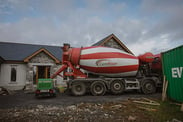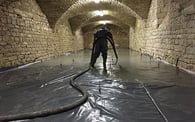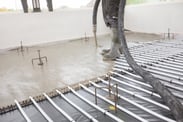Underfloor Heating Systems don’t necessarily affect the drying times for liquid screed. However, you can deploy the UFH to speed up the floor screed’s drying process incrementally.
It’s no surprise that drying times are one of the main concerns when it comes to specifying screed in your commercial or domestic projects. Lengthy drying times can cause project delays and periods of time where all work must be put on hold.
Liquid screed is renowned for its suite of benefits, not least of which is quicker drying times compared to its dry counterpart.
But as the popularity of underfloor heating systems continues to surge in the UK, how do UFH systems affect drying times?
Liquid Screed Drying Times
The drying process is much quicker for liquid screeds when compared to dry screed. Liquid screeds can be laid at much thinner levels, due to their enhanced strength, which makes them more durable even when thinly spread.
Whilst many sources discuss drying times as a guaranteed result in every project, external factors can certainly play a part in extending drying times.
Temperature and humidity have an important role to play in the process, along with moisture ingress. Therefore we offer the following guidance as a general overview of suggested drying times.
Underfloor Heating Liquid Screed – 24-48 Hours
The most important part of the drying process. Once the liquid screed has been poured, it should be left untouched for the first 24 hours. We would recommend keeping all windows and doors closed during this period.
Liquid screeds like Cemfloor are usually fit to walk on after this initial 24 hours, but heavier traffic should be avoided.
Underfloor Heating Liquid Screed – 48 Hours Onwards
Whilst you should attempt to minimise airflow within the space in the first 24 hours, the opposite is true after 48+ hours have elapsed.
At this stage, the floor screed benefits from circulation in the air and warmer temperatures. This will assist in the hardening of the floor screed. As a general rule to follow, the higher the temperature and the lower the humidity, the faster the drying time.
The Screed Drying Process Explained
If the air isn’t circulating, the air around the screed surface will soon obtain a relatively high (wetter) humidity and the screed will dry slower.
If this air is cold, it will be able to “hold” less water and so the drying time will be extended. It is critical that the air is warm and circulating in order to avoid these situations and allow the screed to cure.
A well-ventilated room with warm air is crucial. In truth, despite the fact that both variables have an impact, air movement is the most important aspect.
The Correct Drying Times For Liquid Screed & Underfloor Heating
It’s critical that the underfloor heating floor screed has enough time to dry. If the screed is too wet, the subsequent floor covering may be damaged.
To speed up the drying process, the UFH system can be used to assist, but only after a week has passed. After the first 7 days, the commissioning process can begin with a water temperature of 25oC.
After this initial stage, the liquid floor screed can handle greater temperatures; we advise that you gradually raise the flow temperature by 5°C every day until the water temperature reaches a maximum of 40°C. Maintain this temperature until the screed is completely dry. During this process, ventilation is still critical, so open windows and doors.
Conclusion
Whilst the drying times can remain unaffected by the underfloor heating system, it is possible to speed up the process by using the UFH.
Remember, leave the screed to dry naturally for at least a week before deploying the underfloor heating system.
For specific commissioning times for the underfloor heating system, you should always look at the manufacturer’s spec list. Cemfloor Therm’s guidelines can be found here.
Cemfloor, The Cement-Based Liquid Floor Screed
Whether your project is a commercial or domestic floor, a wet room, contains underfloor heating, unbonded, floating, new build, renovation or multi-storey project; Cemfloor offers cement-based liquid screed solutions for any project.
Designed with ease of installation in mind, Cemfloor Therm has been manufactured with self-leveling and self-compacting properties to speed up the installation process. It can also be installed at much thinner depths compared to other traditional screeds, ensuring ultimate controllability of the underfloor heating system.
If you have any questions about applying floor screed over underfloor heating systems, speak to one of our experts today.
We are always happy to help with any enquiries.







.png?width=300&height=122&name=Untitled%20design%20(34).png)
